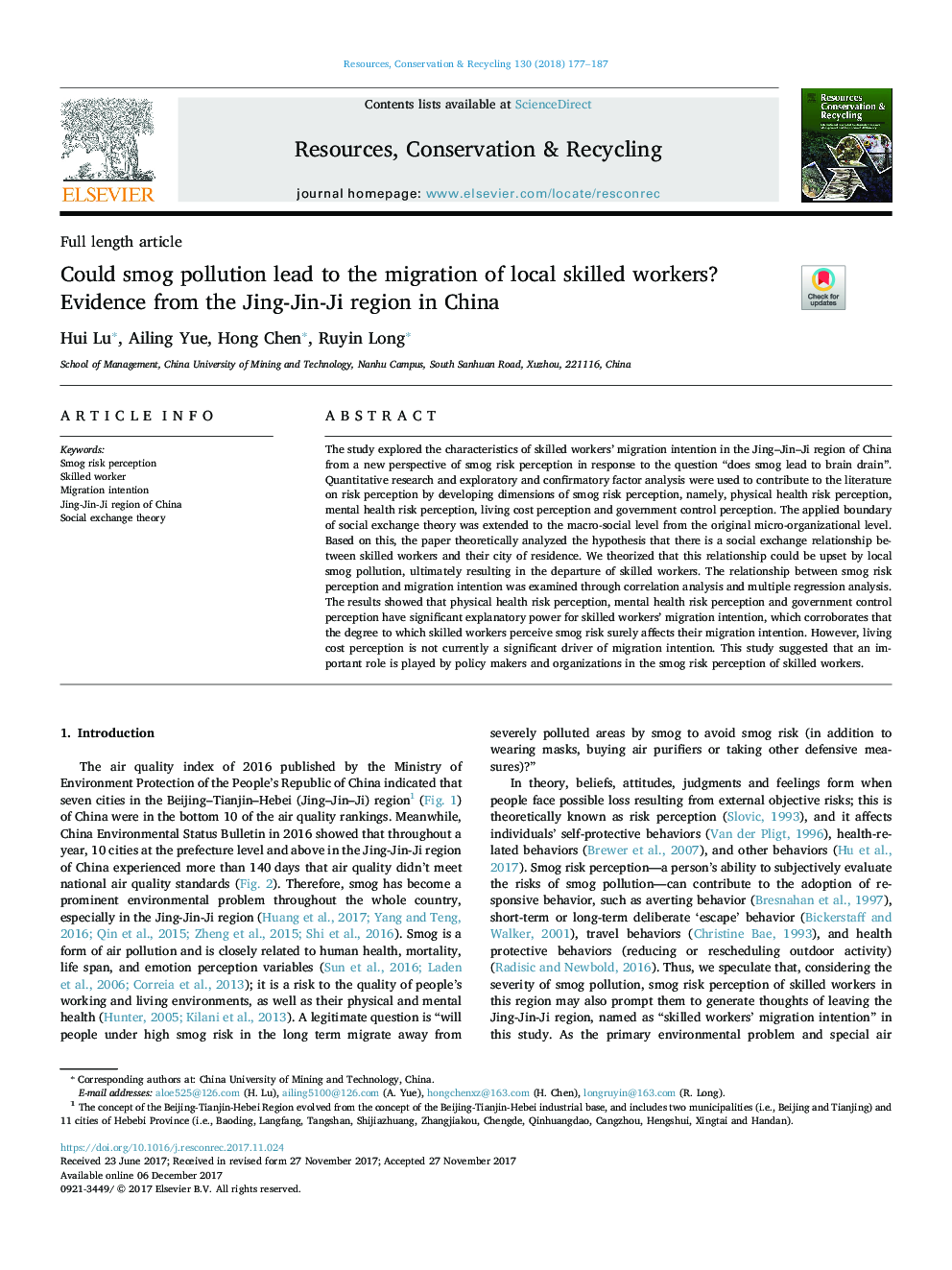| کد مقاله | کد نشریه | سال انتشار | مقاله انگلیسی | نسخه تمام متن |
|---|---|---|---|---|
| 7494459 | 1485662 | 2018 | 11 صفحه PDF | دانلود رایگان |
عنوان انگلیسی مقاله ISI
Could smog pollution lead to the migration of local skilled workers? Evidence from the Jing-Jin-Ji region in China
ترجمه فارسی عنوان
آیا آلودگی می تواند منجر به مهاجرت کارگران ماهر محلی شود؟ شواهد از منطقه جینگ جین جی در چین
دانلود مقاله + سفارش ترجمه
دانلود مقاله ISI انگلیسی
رایگان برای ایرانیان
کلمات کلیدی
ترجمه چکیده
این مطالعه ویژگی های مهاجرت کارگران ماهر در منطقه جینگ جین جی چین را از دیدگاه جدیدی از درک مخاطرات دود در پاسخ به سوال «آیا می تواند منجر به تخلیه مغز» شود؟ تجزیه و تحلیل کمی و تحلیلی و اکتشافی و تایید کننده برای کمک به ادبیات درک ریسک با توسعه ابعاد ادراک خطر دود، یعنی ادراک ریسک سلامت فیزیکی، ادراک ریسک سلامت روان، ادراک هزینه های زندگی و ادراک کنترل دولت مورد استفاده قرار گرفت. مرز اعمال نظریه تبادل اجتماعی به سطح کلان اجتماعی از سطح ابتدایی میکرو سازمانی گسترش یافت. بر این اساس، مقاله به لحاظ نظری فرضیه را تحلیل می کند که روابط اجتماعی میان کارگران ماهر و شهر محل اقامتشان وجود دارد. ما پیش بینی کردیم که این رابطه می تواند با آلودگی هوای محلی ناراحت شود و در نهایت منجر به خروج کارگران ماهر شود. رابطه بین ادراک خطر دود و قصد مهاجرت از طریق تحلیل همبستگی و تحلیل رگرسیون چندگانه مورد بررسی قرار گرفت. نتایج نشان داد که درک ریسک سلامت فیزیکی، ادراک ریسک سلامت روان و ادراک کنترل دولت، قدرت تبیینی قابل توجهی برای قصد مهاجرت کارکنان ماهر دارد که نشان می دهد که میزان آگاهی کارگران ماهر نسبت به ریسک دودی، به طور خاص بر روی اهداف مهاجرت آنها تأثیر می گذارد. با این حال، تصور هزینه زندگی در حال حاضر راننده قابل توجهی از قصد مهاجرت نیست. این مطالعه نشان می دهد که سیاستگذاران و سازمان های درگیر درک خطرات دود کارگران ماهر نقش مهمی ایفا می کنند.
موضوعات مرتبط
مهندسی و علوم پایه
مهندسی انرژی
انرژی های تجدید پذیر، توسعه پایدار و محیط زیست
چکیده انگلیسی
The study explored the characteristics of skilled workers' migration intention in the Jing-Jin-Ji region of China from a new perspective of smog risk perception in response to the question “does smog lead to brain drain”. Quantitative research and exploratory and confirmatory factor analysis were used to contribute to the literature on risk perception by developing dimensions of smog risk perception, namely, physical health risk perception, mental health risk perception, living cost perception and government control perception. The applied boundary of social exchange theory was extended to the macro-social level from the original micro-organizational level. Based on this, the paper theoretically analyzed the hypothesis that there is a social exchange relationship between skilled workers and their city of residence. We theorized that this relationship could be upset by local smog pollution, ultimately resulting in the departure of skilled workers. The relationship between smog risk perception and migration intention was examined through correlation analysis and multiple regression analysis. The results showed that physical health risk perception, mental health risk perception and government control perception have significant explanatory power for skilled workers' migration intention, which corroborates that the degree to which skilled workers perceive smog risk surely affects their migration intention. However, living cost perception is not currently a significant driver of migration intention. This study suggested that an important role is played by policy makers and organizations in the smog risk perception of skilled workers.
ناشر
Database: Elsevier - ScienceDirect (ساینس دایرکت)
Journal: Resources, Conservation and Recycling - Volume 130, March 2018, Pages 177-187
Journal: Resources, Conservation and Recycling - Volume 130, March 2018, Pages 177-187
نویسندگان
Hui Lu, Ailing Yue, Hong Chen, Ruyin Long,
